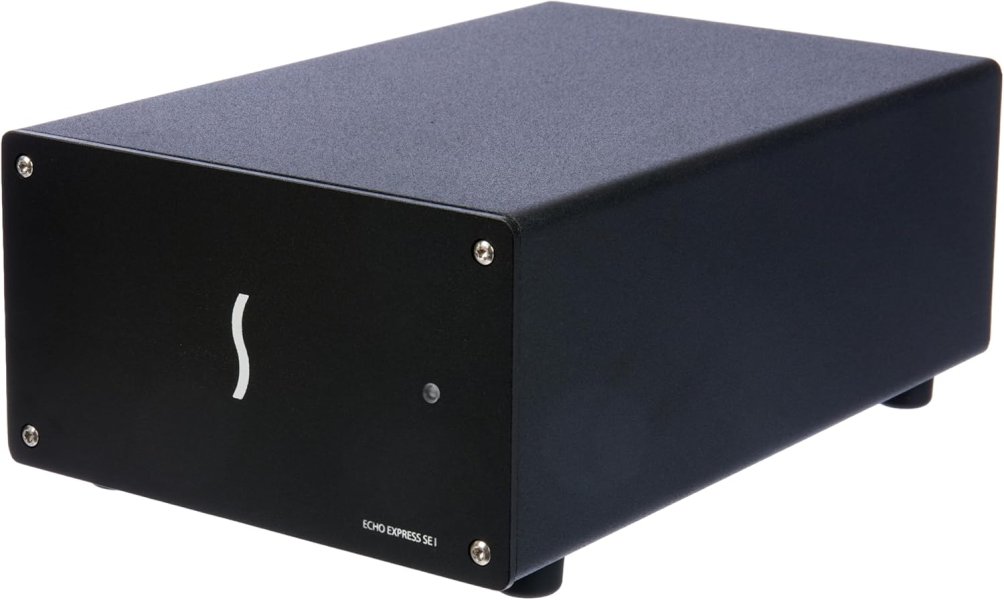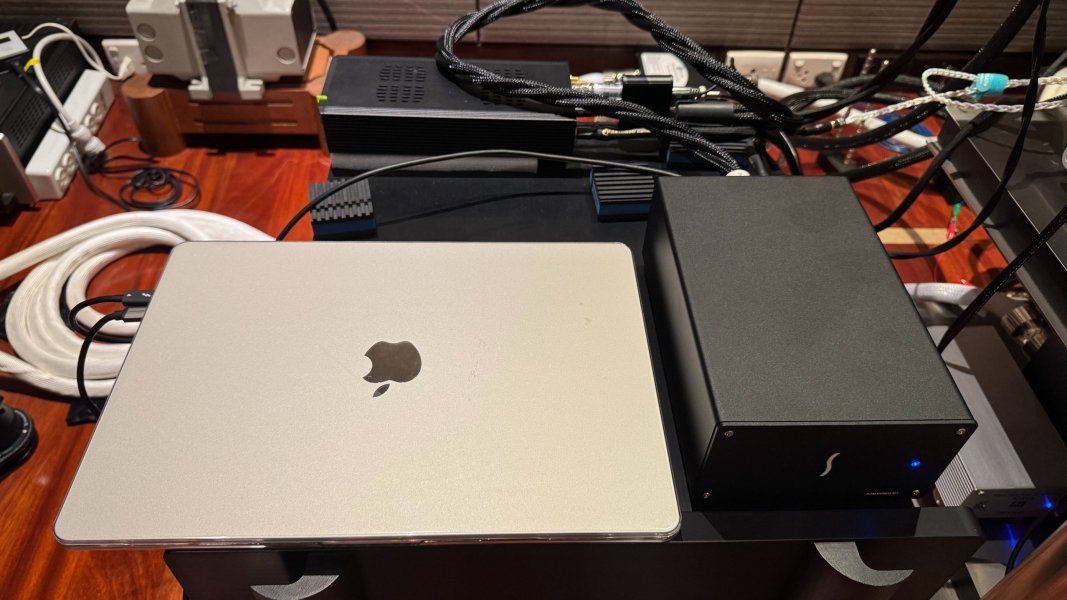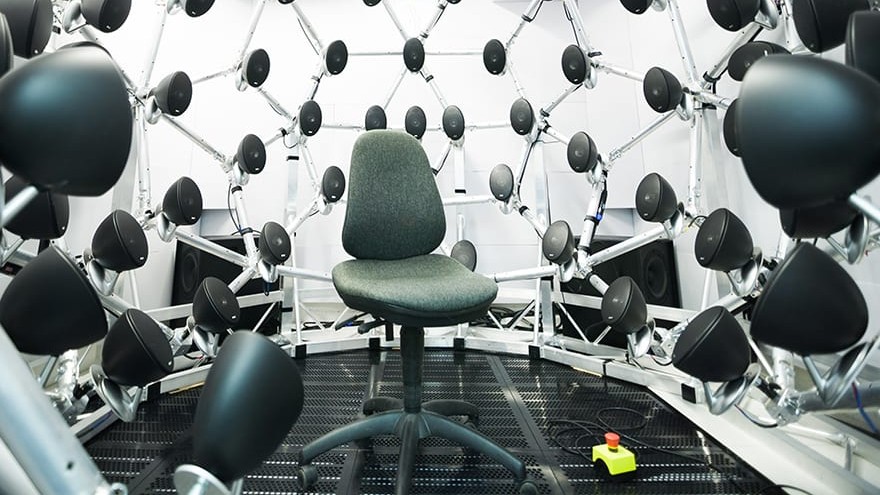Bacch4Mac played through audiophile sound card/bridges is possible!
It’s been a week since I got my parts to adapt my Pink Faun Ultra USB card/bridge into the Sonnet Echo Express SE1 Thunderbolt3 Expansion Chassis (Echo-EXP-SE!-T3) - phew, what a long name!



Glad to report it fits and works as expected. This Sonnet box accepts a USB C Thunderbolt connection from my Macbook and offers a PCIe extension slot. With a short extension cable and some supports, I managed to just fit the Ultra bridge inside in a sturdy way with very little space to spare.





The Ultra bridge is externally powered as is the Sonnet box. Both from my Paul Hynes DR7t+ supply at 5v and 12v respectively. But a bit of history before I get to the sound. The exploratory path I took to get here. I am repeating some of the info I posted earlier but it's mainly for my own reference and makes it easier to read.
Until recently, I was playing the Bacch output directly from my Macbook into the DAC using a Roon core in the Mac. This method allows one to hear the effect of the Bacch filters but it is as low end as it gets as far as hardware is concerned and this is reflected in the sound quality - an average sound with a lack of dynamics and blur focusing. Pretty acceptable, given the startlingly wide Bacch soundstage, for many new Bacch users on trial to see what all the Bacch hubbub was all about. But I wanted to see if the quality of the sound could be improved while keeping the enormous Bacch soundstage.
First I tried putting the USB output of the Mac through a series of USB signal cleaning filters that I have good experience with many years ago when I first experimented with digital cleaning. The Uptone IsoRegen followed by the SOtM tx-USBUltra. Both do a good job of cleaning the USB signal a touch but the tx-USBUltra has the added advantage of adding an external Reference Clock which I added my unused Cybershaft OP-14 so I used this as the end point before the DAC and wrote about it earlier
here and
here. Both devices powered at 9V by the PH DR7t+.
Immediately the effect was a better sound, the image tightened up considerably and there was a wider difference between the quiet passages and the loud ones. This proved to me that the Bacch filtered USB signal from the Mac could be improved and it was worth perusing towards my ultimate goal - passing the signal into an audiophile sound bridge and using that as the last signal generation before the DAC. Especially so if this bridge had a good clock.
So next was to try the PCIe extension box mentioned above. I have a few USB sound cards on hand and I initially started with the Pink Faun USB v2. An unusual card with a clocking frequency at 40MHz instead of the standard 20MHz. The card work almost immediately and it sounded good but not at the level I had expected it to. Perhaps the Sonnet box and cabling was still breaking in? Or perhaps the v2 card had been resting for over a year? I tried passing the output USB signal into my USB cleaning setup and then the sound settled nicely. A good step up, more clarity, better soundstage placement than just the cleaning setup. Bacch soundstage is already second to none but with that additional clarity and solid image placements, it’s something to behold. Very nice.
Why not go straightaway into the Ultra card/bridge? Because it didn’t fit. This bridge is designed specifically for the Pink Faun’s Ultra streamer and only this streamer. The shape doesn’t allow it to be adjusted to fit other streamer/computer slots. So I used a 5cm ADT Link PCle riser extension cable R11SF and some supports to make it work. The Sonnet has an in built fan which I felt was unnecessary so I disconnected it to reduce electrical disturbance but left the LED light on.
The final physical setup was done but the device wasn’t recognised by the Mac. After some trial and error tests I found that the Macbook had to be disconnected from the Sonnet box for a few hours and then reconnected for it to be recognised for the first time. Thereafter it's fine. An unusual requirement, different from the v2 card which connected without issues.
And the sound..
The Ultra bridge hadn’t been in use for many months, it was disconnected from power and the Ultra OCXO clock inside was cold. I knew this and that it would take a few weeks for the sound to return to what the Ultra was capable of but right off, the sound of Bacch through the Ultra bridge was already astonishing. As wide as the Bacch soundfield is, the Ultra was making it even wider while maintaining resolution at the extreme width. The images I heard at the peripheral soundfield were clear and full ranged. Looked like the bridge's UltraCap power inside and their signal isolation tech was working well.
Would it be further improved through the USB cleaning filters? Nope, a clear step down doing so. A direct connection from sound card/bridge to DAC sounds the best. How does it compare with the sound of the Ultra bridge in my PF streamer in conventional stereo? Initially, not quite the same level of details and emotional impact yet but far better in soundstage and accuracy of sound, the latter probably due to the Bacch filters being room and system corrected. Very few, if any, albums sound wrong, pretty much all tracks sounds audiophile and closer to the truth. Booting the Macbook in 'Safe Mode' also made a clear improvement to the sound.
I feel there is still some optimisation work to do on the presentation of details but after only a week of warming the clock in the bridge (current time now), and replacing the Roon core with a Roon bridge in the Macbook and moving the core to an simple external player, there is a clear improvement with the emotional connection now being closer to the Ultra bridge under stereo conditions.
With my experience today of the Bacch sound through my Ultra USB bridge, I will not be returning to stereo anytime soon. No matter what highest end equipment is being used for playback, and I’ve heard quite a number of them in my own system and in other systems, the distortion of crosstalk isn’t being addressed and so soundstage images can only be guessed at by the brain. Despite a non-audiophile Macbook is being used to calculate the realtime Bacch filters, having a high end sound card attached seems to have significantly improved the sound quality - to an audiophile level. Similar to the Bacch-SP dedicated players? Or perhaps even beyond them?

What’s next? For hardware, until some manufacturer finds a way to incorporate the Bacch crosstalk removal filters in their streamers, there isn’t much else to improve on. Perhaps testing different USB thunderbolt cables? Or trying a Mac Mini or Mac Studio rather than a Macbook? But I would loose the ability to transport the Bacch to my other music systems and I would be using a switching supply instead of the Macbook battery. I can work further on the Roon core hardware as I am using a simple SonicTransporter for that currently. For software, it might be good to explore software outside Roon which I have not used in years for audiophile listening - it being nearly the worst sounding software in my experience to date. If I can get Euphony to play into Bacch it would be exciting. Right now, Bacch doesn’t accept UPnP connections so there is no straightforward way to do this. Using the Mac as a Roon endpoint is currently the easiest way presently and seems to sound good enough for now.
So in summary, my playback system today:
Macbook M2, running Bacch4Mac (connected to RME Babyface Pro and head tracking video camera) and Roon endpoint. USB Thunderbolt 3 connected to ->
Sonnet Echo Express SE1 with Pink Faun Ultra card/bridge installed. 12v power by Paul Hynes DR7t+. QSA Landri USB cable output to ->
Vinnie Rossi L2i-SE DAC2
I hope this experience writeup benefits others using the Bacch4Mac software. There are ways to push the sound quality up substantially without high costs.














